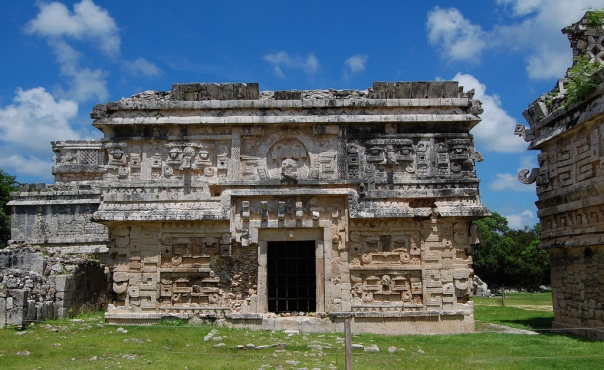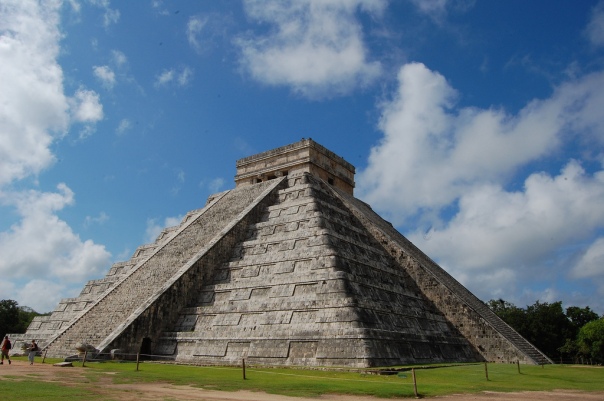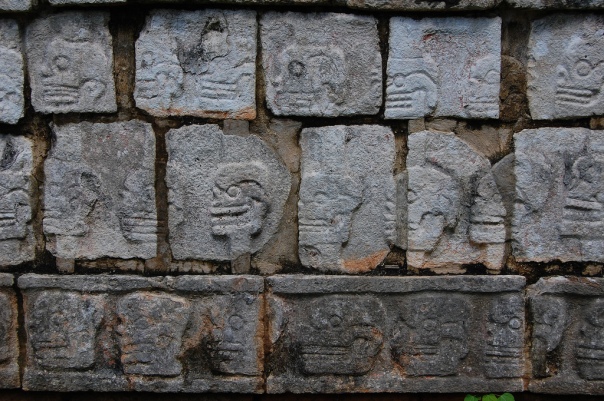Blog Archives
One Day on Isla Mujeres
The origin of the name Isla Mujeres is debated- some theories assert that the name comes from the statues of the medicine and childbirth goddess, Ixchel, found at a Mayan temple on the south of the island. Others say that the name comes from the fact that the Spanish explorers left their womenfolk on the island before heading into the Yucatán.
No matter the nomenclature, the island is truly beautiful. Sitting offshore, it has maintained its incredibly chill vibe despite the proximity of frenetic Cancún. It’s a decidedly Caribbean place, where the pace is determined by the sea and sand.
First, Playa Norte-
… it’s a gem of a beach. Just off the main town, it is very well appointed with bars and bathrooms nearby. For 150 pesos (13 dollars or so) you can rent a pair of lounge chairs and umbrella at the edge of the water for the entire day. You’d think there’d be a crowd here, but the place was wide open- at times I was the only one swimming.
The water is impossibly clear and blue, and very swimmable, despite a strong side current. Towards evening a school of thousands of tropical fish appeared, racing along at crazy speed around my legs.
It feels as though one could spend an eternity here.
//
As evening begins to fall and the heat becomes bearable again, people start lazily coming off the beach and into the town. In the narrow streets, small restaurants begin opening their doors while street vendors, selling everything from jewelry to plastic toys, try to snag would-be shoppers. Bicycles and golf carts (some packed to the brim) abound on the narrow, colorful streets filled with lazy markets and passers-by.
Outside the stores on the corner, people congregate for evening chats. There’s a certain endearing eccentricity to this place- at one point a beat-up old humvee rolled up, coughing diesel, driven by a huge shirtless guy with scraggly long hair. He stopped to talk a while and then moved on. Meanwhile, just out of view, local teenagers with a laptop were trying to tap into a rogue wireless signal…
//
It was a really nice ride back to the mainland-
The scene felt like one giant sigh that comes after a day at the beach- huge extended families covering 3 generations posed for pictures, while couples stared up and watched the stars begin to appear. The ship’s lights illuminating the bright blue water around us. At some point between Isla Mujeres and Cancún -the lights of both twinkling far in opposite distances- in the middle of the dark bay, a salty breeze kicked up. Above all the festivities and the blaring Mexican pop music and satiated joy, you could just make out the eternal serenity of a calm sea under moonlight.
Deep in the Yucatán – Valladolid, Mexico
There is a gentle magic on the hazy roads leading to Valladolid – For miles you travel through nothing but the flat, interminable expanse of the Yucatán jungle. The monotony, coupled with the heavy air, and brilliant clear sun, becomes hypnotizing. Wondrously amplified details begin to emerge from the feverish trance – small yellow butterflies float out of the trees, and huts of villages glance out from here and there, their presence revealed sometimes only by the smoke of cooking fires. Occasionally, in the middle of nowhere, a lone traveler stunningly appears on the side of the road, pushing a cart or riding a bicycle… going to who-knows-where.
Arriving in Valladolid abruptly snaps one back into reality. The narrow, brightly colored streets are a flurry of activity -stores specializing in leather and clothing; -food vendors selling strange fruits, medicines, and streetfood; -bicycles, cars, traffic cops swarming everywhere. The sun sears even more than it did out in the jungle. Once in while, you see women, often in pairs, wearing striking Mayan huipiles – dazzling white blouses decorated with intricate embroidery. An elderly woman or two sit in doorsteps, sewing. The Spanish here is accented by Mayan, and occasionally you hear pure Yucatec Mayan being spoken, as it is still the first language of many.
The ancient Maya had a town here called “Zací”, which was destroyed by the Spanish under a nephew of the conquistador Montejo (now the namesake of a local beer) family. They had established a town further away, but plagued by mosquitos, they arrived here and established Valladolid on March 24, 1545. The Mayans of the region, of course, did not take kindly to this invasion and, and in the face of horrific horrific exploitation, staged numerous revolts over the following centuries, culminating in the Caste Wars of the 1840’s, in which the town was sacked and many of the residents slaughtered. In other parts of Mexico, the tensions and fallout stemming from the Spanish colonial system still run very high, but here there seems to be some peace at the moment.
It’s a small town, and you seem to run into the same people over and over again. Due its proximity to some major archeological sites, it has begun to see more tourism over the past ten years- predominantly backpacker types- We twice bumped into some Germans who were traveling through the Yucatán and Central America. And as far as we could tell, we were the only Americans in town.
It’s a compact place centered around the zócalo, near which are a number of modest hotels and a handful of exceptional restaurants.

near the Zócalo - just before an evening storm knocked out the town's electricity for about an hour or so
The food of the Yucatán is unique. To name a few dishes: pollo escabeche (chicken with a huge pepper and pickled onions in a vinegary sauce), cochinita pibil (pork rubbed with a red adobo, wrapped in leaves, and slow-cooked in an underground oven), Longanizas Valladolid (Valladolid style sausage, loaded with spices), sopa de lima (a chicken soup with lime, poc chuc (a sort of barbecue grilled pork), and the ever-present fresh tortillas.

These giant sinkholes, known as cenotes, dot the limestone landscape of the Yucatán. Some, like at Chichen Itza, are open wells; some are completely subterranean; and many, like this one, are sort of in between. Because the Yucatán lacks river systems, human settlements tended to gravitate to cenotes. Zací sustained the Mayan town that was here before the Spanish, and probably sustained the Spanish as well, early on. Today they make for great swimming holes.
Valladolid is near a number of archeological sites, including Chichen Itza and Uxmal. If you don’t have a car, there are “colectivo” vans that you can grab for very cheap. They may be hard to find, but if you ask a police officer, he or she can point you in the right direction – knowledge of basic Spanish is very helpful. The ride to Chichen Itza takes about 50 minutes and winds through the blank jungle, passing through smoky villages where little kids sell juice and trinkets by the roadside. Along the way, passengers come and go – We had a fun time with a party of Jehovah’s Witnesses for a number of miles.
More photos here: http://www.flickr.com/photos/mattron/sets/72157624680849972/with/4875923782/
The ruins of Chichén Itzá
Nestled deep in the forests of the interior of Mexico’s Yucatán Peninsula sits one of the world’s foremost archeological sites – Chichén Itzá.
It was a city built to intimidate, influence, inspire, and empower- and as such, it is not at all unlike the cities we know and live in today. The practices carried out here were so alien to what most of us know today, but nevertheless, we can still understand what it is like to exist in a certain time and place, and to define where we are as home, for all better or worse.
The ruined buildings here display a great deal of imperious civic pride. But it’s thinking about the day-to-day that is most compelling. Countless people walked these streets, entered these buildings- each with their own hopes, dreams, and intrigues. Each trying, within the society they were brought up in, to make sense of the world around them. Each with their pleasures, vices, gripes, and shortcomings. Some with imagination that could vault the stars. Some who devoted themselves wholly to the city and society around them, and surely others who dissented, perhaps quietly, living entire lives under the radar. In terms of the day-to-day, it is poignant to think of all the countless mornings in which the residents of Chichén Itzá walked out of their homes and casually gazed at the huge pyramid and surrounding grandeur and perhaps marveled that humans could be capable of such things.
But what other people shrank back in horror- disgusted by the brutality of humanity?
and how many countless others were perhaps mortally terrified of their rulers and the constant bloodshed of their religion?
It is also captivating to think of how many people might have taken their cityscape for granted. We have no real way of knowing whether or not our most cherished modern monuments will someday be ruins themselves, drawing from strangers a similar sense of wonder and mystery, a thousand or two thousand years hence.
The name Chichén Itzá means “at the the well of the Itzá”, a reference to the Cenote Sagrado (a huge sinkhole) which provided the water to make this city flourish in the riverless Yucatán.
The city was regionally significant as far back as AD600, during the Classic Period of Mayan history. At that time, as the major Classic Period city-states further south, such as Tikal and Palenque, enjoyed being at the very heart of civilization, this was something of a far-off backwater outpost.

"La Iglesia" - an example of pre-Toltec, classal Puuc style architecture. These light and intricately detailed buildings are a great contrast to the later, more totalitarian architecture. The imagery of death and blood is largely absent from this older section of the city.
The oldest visible remaining architecture here represents the Puuc (“hill” in Mayan) style and was probably built around 900AD. Sometime soon after that time, Chichén Itzá underwent a huge upheaval. This was the end of the Classic Period, when the great civilization of the south was collapsing (for reasons unknown, but probably tied, at least in some way, to overexploitation of the environment).

Temple of the Warriors, in the domineering style of the Toltec-influenced period. The columns in front were once supported an enclosed complex- perhaps an administrative building.
As many of the major centers of Mayan civilization collapsed, Chichén Itzá came under great Toltec influence- the Toltecs had their capital at Tula, in the west, near Mexico City, and were the precursors to the Aztecs. Whether the Toltec influence was via direct invasion or via the Itzá Mayans is still debated. Either way, the city became deeply connected to the ideology of Central Mexico- an ideology which was strongly connected to the idea that the perpetuation of earthly life was only guaranteed by sacrifice to the gods- a bloody, bellicose tradition that is exemplified throughout the newer portions of the city. The very same spectacular architecture that captivates visitors today seems, in some ways, to be desperate expression of a culture in decline, a culture trying to keep hold of itself….
In short, the older portions of the city demonstrate a deep connection to its Classic Mayan predecessors, via the Puuc tradition; and the newer portions (ca. AD 1000) demonstrate a fractured, and more desperately extreme time, highly swayed by outside forces. I have read that anywhere from 35,000 to 90,000 people lived here at its peak- a huge number for ancient times.
Turmoil continued into the 1200’s, after which point the city finally declined totally, being absorbed by the Spanish in the second half of the 1500’s.
If you really want to truly appreciate this astounding place, find a way to come early in the morning- i.e. stay in a local town. We arrived at around 9am and had the place to ourselves- in the midday, just as the sun is becoming unbearable, (which is amazingly taxing on the brain, as we dizzily found out) hoards upon hoards of day-trippers arrive on buses, and what is so tranquil in the morning becomes a cattle run. We thankfully managed to stay a few steps ahead of the crowds. Definitely bring a ton of water, and be prepared to bake like you’ve never baked before in the extreme sun.
Notable sights:
Templo de Kukulcan
This immense pyramid is rife with calendrical numerology. There are 91 steps on each of the 4 sides. These 364 steps, plus the final step at the top before the altar correspond to the solar year. The pyramid is terraced into 9 sections divided by a staircase, commemorating the 18 20-day months of the Mayan calendar. Each of the four facades includes 52 panels, which correspond to the 52 year cycle of the Mayan long-count calendar. On the vernal and autumnal equinoxes, a serpent-shaped shadow appears to descend the steps in the form of Kukulcan, (something like the Mayan version of Quetzalcoatl)
The Great Ballcourt
There are 8 ballcourts at Chichen Itza, and this is the largest, and the largest in MesoAmerica.
It is spectacularly huge (about 300ft long) and the acoustic effects within, like at other places in the city, are extraordinary.
The rules and meaning of the game changed over history and according to region, but it was played in many cultures for centuries and sometimes included some degree of ritual bloodshed
Some of the deathly imagery surrounding the ballcourt:
Group of a Thousand Columns
This vast complex was once enclosed and perhaps was a focal point of governmental administration. Nearby, there are ruins of a bathhouse which housed both steam and cold baths.
El Caracol
The Spanish gave El Caracol its name because of the spiral staircase within. It is an immense observatory, built in a Classic style common further south- There are chac mool’s (a seated figure) dedicated to the rain god at each cardinal point and the windows in the tower are aligned with Venus and other stars at certain times of year.
The movement of the stars, and the calendar was integral to Mayan spirituality and worldview. The Mayans were perhaps the most astronomically sophisticated people in the world before the Renaissance and were able to predict eclipses centuries in advance, and to track the path of planets with great accuracy.
Cenote Sagrado
In the riverless Yucatán, settlements were often built near the numerous sinkholes, or cenotes, which dot the limestone region. Following a sacbe (a Mayan road with white pavement) from the city center, one finds this life-water of the city. In the early 20th century, archeologists found evidence of human sacrifice at the bottom of the Sacred Cenote. This is also the place which gives the city its name – Chichén (“near the well” of the Itzá (an ethic group that existed in this area))
a simple home
Most of the residences in the city were probably wooden structures much like some present-day Mayan homes. They have rotted away ages ago. But this stone structure has lasted somewhat. It was once someone’s home in the middle of the great city, possibly that of someone who tended one of the nearby temples. So many men, women, and children came and went through that door, living their day-to-day lives…
etc.






































